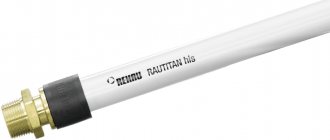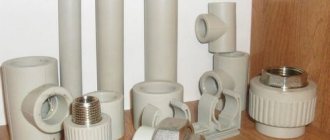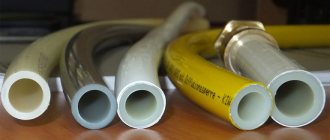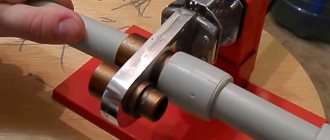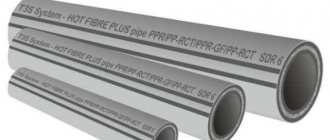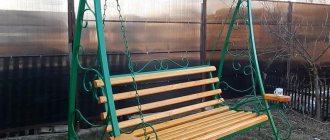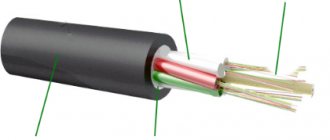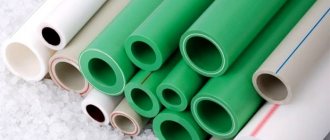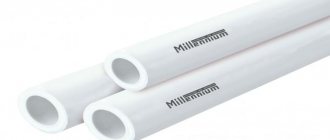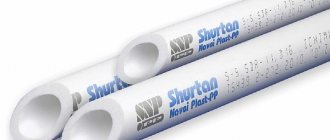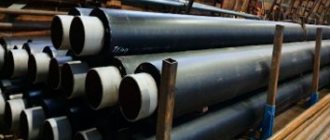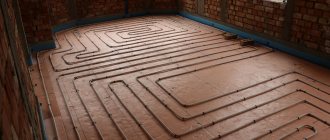The most important component of any heating system is the pipeline through which the coolant circulates from the boiler or heating point to the radiators and back.
Pipelines often form a complex branched network. Its performance determines the efficiency of space heating, and possible accidents and leaks lead to serious consequences. Therefore, much attention is paid to the materials used to complete them.
Until recently, exclusively steel VGPs were used for wiring heating systems. However, today they are actively being replaced by reinforced polypropylene pipes. They have increased reliability and durability, are easy to install, have an aesthetic appearance and do not require painting. At the same time, when choosing reinforced polypropylene pipes, it is necessary to take into account that they can use different types and materials of reinforcement, and also have different qualities. Not all of them are ideal for these purposes. Therefore, you need to understand how to choose the right reinforced polypropylene pipes for heating purposes.
Features of PPR pipes
Main advantages:
- Long service life.
- Low price.
- Absence of corrosion processes typical of metals.
- The smooth inner surface allows for increased fluid pressure.
- Quiet transport of water or other liquids.
- Easy to perform installation work.
- It is possible to install taps without using threaded connections using soldering equipment.
- There is no need for periodic maintenance of pipe and butt joint blocks. This allows you to install it under the floor or under the plaster finishing layer and forget it for a long period.
Along with the positive qualities and features, we must not forget about some disadvantages when choosing polypropylene pipes. The pipes have low ductility and bend poorly, which does not allow for corner wiring. Intermediate couplings of the appropriate profile are required, bent at the angle at which the pipeline needs to be rotated. If damage to the material occurs during installation, the product will have to be thrown away and replaced with a new one. If a defect occurs, the structure can no longer be repaired. The entire section of assembled pipes will have to be cut out and reinstalled. For installation work, you need special pipe cutting scissors and soldering equipment.
Some of the problems are eliminated thanks to the packaging: a large number of auxiliary parts - fittings and couplings - makes it possible to assemble and create structures from pipes of various configurations, up to the most complex ones.
Types of PPR pipes
Products vary in layering factor. Main groups:
Single-layer pipes are widespread, this is due to their low price. At the same time, they cannot be used for pipelines with high heating temperatures. If the liquid is heated above 70 degrees Celsius, significant linear elongation of such products occurs. Single-layer polypropylene pipes can have different chemical compositions and use different polymers. The type of chemical compound determines the performance properties of the product. Therefore, you should always take a closer look at the markings of pipes in order to understand for what purposes they should be used. How single-layer pipes are marked:
| Marking | Name | Description | Areas of use |
| RRN | Homopolymer | Hard material. · Low resistance to low temperatures. | · Transportation of cold and hot water. · Ventilation devices. · Production pipelines. |
| RRV | Block copolymer | Flexible material. · Frost-resistant. | Cold water supply. "Warm floor". |
| PPR | Statistical copolymer | Durable material. Withstands simultaneous short rises in temperature up to +110 degrees. WITH. Restores after defrosting. Resistant to aggressive environments. Good soundproofing properties. | Transportation of cold and hot water. Heating in an individual house. |
| P.P.S. | Special polymer |
Multilayer pipes, otherwise called reinforced. Reinforcement is an option to increase the load-bearing capacity of a product by using additional layers of materials; they strengthen the product and prevent the walls from excessively expanding and lengthening.
Reinforcement of PPR pipes to reduce elongation is of two types:
- Aluminum.
- Fiberglass
The metal in polypropylene pipes is an excellent material that increases strength. Ways to work with it:
- Adhesive application of a strip layer of foil on the outside of the pipe, which is overlapped or butted.
- External application of perforated metal sheet.
- Lining the interior with a layer of foil also with glue.
- Welding AL sheet at the joint to create a sealed space inside the pipe.
- Fiberglass reinforcement. It is located on the inside of the pipe; composite material can also be used - with the addition of polypropylene. The material increases resistance to high temperatures and reduces costs during assembly work.
- Reinforcement with basalt fiber. This is a relatively new material on the market. It has a number of advantages over existing options. It is believed to be more durable, resistant to pressure changes and high temperatures. The pipe capacity is higher with less weight. Basalt is an environmentally friendly material
Structure and advantages of PPR elements with fiberglass reinforcement
As already mentioned, in the manufacture of PPR it is possible to use two types of reinforcing materials - fiberglass component and aluminum foil. However, it is pipes with fiberglass for heating that are the best option.
Such products have a three-layer structure. The reinforcing layer is located between two layers of polypropylene. The manufacturing technology provides for an almost monolithic connection of the layers to each other. This makes it possible to almost completely eliminate the possibility of delamination of fiberglass-reinforced pipes under the influence of high temperatures. Due to the reinforcement, thermal expansion is significantly reduced, which makes it possible to install heating networks from polypropylene pipes.
Fiberglass has almost the same coefficient of linear expansion as aluminum (within the range of 0.03-0.035 mm/m×°C). At the same time, when performing the functions of a reinforcing material, it is characterized by a number of significant advantages over aluminum foil:
- a continuous, seamless layer, unlike aluminum foil, which is joined by welding, and in some cases simply overlapped;
- excellent anti-diffusion properties, which can effectively prevent oxygen from entering the coolant. Due to this, the use of fiberglass-reinforced pipes serves as an excellent prevention of corrosion of the metal elements of the system;
- easier installation without the need for stripping. High quality and reliability of welded joints;
- improved thermal insulation, which reduces heat loss from the coolant.
Based on these advantages, we can say that for heat supply purposes, fiberglass pipes are the best option. When choosing, you also need to consider the size. For installation of risers, reinforced polypropylene pipes PN-20 and PN-25 with a diameter of at least 32 mm are best suited. Eyeliner can be done using elements of the same type with a diameter of 20-25 mm.
Marking of multilayer pipes
This group has a complex naming system
| Marking | Indication of the type of reinforcement |
| PPR-AL-PPR | Aluminium foil |
| PP-RCT-AL-PPR | Modified polypropylene, aluminum foil, polymer outer layer. |
| PPR-FB-PPR | Fiberglass layer on the inside. |
| PPR-FB-PPR, PPR/PPR-GF/PPR | Composite material: fiberglass + polypropylene. |
| PP-RCT+BF | Basalt layer |
Product color
There are PPR pipes on the market made from materials of different colors. Is there a difference when choosing? Can we say that a gray pipe is better than a white one?
Experts are divided over this indicator: some believe that shades do not affect anything and that this is just a marketing ploy. However, there are many descriptions of products that differ in color, which present different operational, performance and economic characteristics.
For convenience, the estimates are tabulated:
| Pipe color | Performance properties |
| White | Long service life. The maximum pressure withstand is twenty-five bar. Low cost. Not subject to corrosion. |
| Grey | Ability to withstand elevated temperatures Ability to withstand aggressive environments: acidic and alkaline. Long period of operation. Environmentally friendly. High level of tightness. |
| Black | Immunity to ultraviolet rays. Ability to withstand aggressive environments. Resistance to drying out. Increased strength |
| Green | Cheap option, low operating pressure. Suitable, perhaps, for a country shower and watering the garden. |
Types of polypropylene pipes presented on the domestic market
Currently, polypropylene pipes are available to domestic consumers in a wide range of colors.
The colors of polypropylene pipes are selected depending on the area of future use. The color of the pipe will tell you about the features of its application.
White polypropylene pipes
When installing water supply lines, it is recommended to use white pipes made of polypropylene. They are easily welded, allowing installation to be carried out in record time. Since at a temperature of 0 degrees polypropylene begins to change its structure (crystallize), it is not recommended to use white pipes made of this material in outdoor conditions
Even transporting polypropylene pipes at this temperature must be carried out with extreme caution, since any mechanical and physical impact can cause damage. White polypropylene pipe has many advantages:
- the longest possible useful life;
- ability to withstand pressure reaching 25 bar;
- low cost;
- resistance to corrosive changes, etc.
White polypropylene pipes
White PP pipe cannot be used when installing street communication systems that will be operated in unfavorable climatic conditions, at low temperatures. This should be taken into account when drafting future communications.
Gray polypropylene pipes
Gray polypropylene pipes are often used when installing water supply systems, and are also suitable for creating both centralized and individual heating systems. They have excellent technical properties:
- thermal stability;
- chemical resistance;
- long service life;
- environmental friendliness;
- tightness, etc.
Black polypropylene pipes
When creating sewer communications and drainage systems, it is recommended to use black polypropylene pipes. In their production, special additives are used that improve their technical capabilities. Black polypropylene pipes have the following advantages:
- resistance to ultraviolet radiation;
- resistance to various aggressive environments;
- resistance to drying out;
- high strength, etc.
Green polypropylene pipes
When installing irrigation systems in household plots, green polypropylene pipes are most often used, since they are not very resistant to the internal pressure exerted by water
Such pipes are sold in a fairly low price range, so land owners do not pay too much attention to their strength characteristics. Recently, some manufacturers have begun to pay more attention to the technical characteristics of pipes made of green polypropylene, thanks to which such material can be purchased on the domestic market, suitable for installing cold water pipes in residential premises
Green polypropylene pipes
Green polypropylene pipes do not withstand any physical impact, including pressure
It is important to regularly monitor the condition of the created communication, as there is a high risk of pipe bursting.
Selection of pipes for water supply
Polypropylene piping components are a practical and relatively inexpensive option for installing water pipes in homes.
To supply cold water, a simple version of polypropylene pipes without special layers that strengthen the element is suitable. These are inexpensive single-layer pipes without reinforcement. Feel free to choose them.
RPH single-layer pipe made of solid homopropylene, durable, can withstand heating up to 60 degrees C, higher temperatures are not recommended
PPV single-layer pipe made of flexible block copolymer, resistant to defrosting.
PPR single-layer random copolymer pipe, more durable and resistant to temperature rise, recovers after defrosting.
They differ in diameter - from 20 to 40 mm, and shell thickness - from 1.9 to 6.7 mm. The shell thickness is indicated by the parameter PN10 or PN20. These parameters affect the hydrodynamic properties of the system and the throughput of the water supply system. Pipes ⌀ 32 mm are connected to the central water supply; for internal communications, ⌀ 16 - 25 mm are sufficient.
To supply hot water, it is possible to choose the connection of single-layer inexpensive polypropylene pipes:
- PPR, PPRC from a copolymer of propylene and ethylene - coolant temperature less than 70 degrees C
- PPS – made of special polypropylene – heating no more than 95°C
However, for greater reliability it is worth using reinforced pipes. Experts recommend pipes reinforced with fiberglass:
PPR-FB-PPR – propylene sandwiched with fiberglass fiber
PPR/PPR-GF/PPR – three-layer pipe, inside and outside made of polypropylene, the middle layer is made of a composite material in which glass fiber is distributed in a polypropylene matrix. A colored intermediate layer on a light background is a distinctive external feature of these pipes.
They are produced, for example, by the Italian-Chinese company Valtec and the Russian company Kontur. They are superior to aluminum-coated options in a number of characteristics; they are easier to install, do not need to be cleaned during assembly, and do not swell during operation or collapse from the inside.
Meanwhile, aluminum pipes are impermeable or almost impermeable to oxygen. This is an important property, since oxygen, saturating the coolant water with bubbles, creates so-called cavitation processes in all metal components of the water supply system. They destroy the walls of pumps, valves and other parts.
The main differences between reinforced pipe and standard pipe
The first thing to determine is: what is a regular polypropylene tube? Most often it is used when working with cold and hot drainage, due to the almost non-existent heat resistance of the first two types of markings:
- Type 1 polypropylene or PP-H (polypropylene homopolymer). At temperatures below “zero” it periodically crumbles.
- Type 2 polypropylene or PP-B (block copolymer). Less sensitive to temperatures, flexible, easy to install.
- Type 3 polypropylene or PP-R (random copolymer). Less susceptible to chemical and temperature effects. Withstands up to +145-175°C.
All manufacturers of standard pipes will tell you that the main difference between these pipes is operational safety.
Due to their plasticity, conventional pipes increase in size in high-temperature environments. If the pipes are installed in an open space, nothing critical will happen, but if they are “hidden” in the walls or floor, they can cause a crack or even break the surface. To avoid such troubles, competent installers use parts in a solid frame.
Naturally, there is more than one difference:
- Different pressure tolerance. PPRC retains its hardness better at higher pressure ranges.
- Linear expansion. Unreinforced pipes undergo 75% more modification. If the temperature in Celsius is above 70 degrees, 1 cm per 1 m of pipe is deformed. For reinforced polypropylene pipes, the figure drops to 1-3 millimeters for the same length.
- Sustainability. Reinforced pipes guarantee durability due to the reduced risk of corrosion and mechanical damage.
Selection of heating pipes
The choice of heating system components is influenced by the same properties of polypropylene pipes, which are important for the supply of hot water. First of all, the quality of the polymer itself.
Inexpensive single-layer block copolymer PP pipes can be used in low-temperature heating systems
P.P.S. made of a special polymer without reinforcement are used for heating, provided that the temperature in the system is less than 95 degrees C
However, reinforced products for heating purposes are more reliable and acceptable.
PPR-AL-PPR – with an outer layer of aluminum film. PP-RCT-AL-PPR – a new type of propylene is used, sandwiched with aluminum with an external polymer coating.
PPR-FB-PPR – propylene layered with fiberglass fiber.
PPR/PPR-GF/PPR – three-layer, inside and outside made of polypropylene, the middle layer is made of a composite in which glass fiber is distributed in a polypropylene matrix.
PP-RCT + BF is a pipe with basalt fiber, characterized by low weight and good throughput.
Reinforced pipes are more expensive, but also more reliable; they are initially produced for coolants with a wide temperature range.
